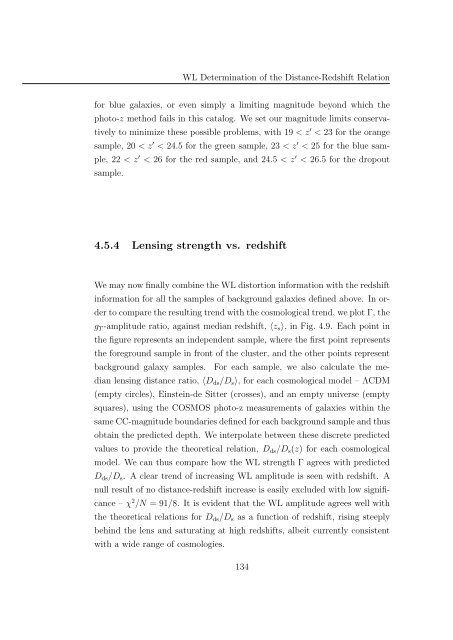Mass and Light distributions in Clusters of Galaxies - Henry A ...
Mass and Light distributions in Clusters of Galaxies - Henry A ...
Mass and Light distributions in Clusters of Galaxies - Henry A ...
Create successful ePaper yourself
Turn your PDF publications into a flip-book with our unique Google optimized e-Paper software.
WL Determ<strong>in</strong>ation <strong>of</strong> the Distance-Redshift Relation<br />
for blue galaxies, or even simply a limit<strong>in</strong>g magnitude beyond which the<br />
photo-z method fails <strong>in</strong> this catalog. We set our magnitude limits conservatively<br />
to m<strong>in</strong>imize these possible problems, with 19 < z ′ < 23 for the orange<br />
sample, 20 < z ′ < 24.5 for the green sample, 23 < z ′ < 25 for the blue sample,<br />
22 < z ′ < 26 for the red sample, <strong>and</strong> 24.5 < z ′ < 26.5 for the dropout<br />
sample.<br />
4.5.4 Lens<strong>in</strong>g strength vs. redshift<br />
We may now f<strong>in</strong>ally comb<strong>in</strong>e the WL distortion <strong>in</strong>formation with the redshift<br />
<strong>in</strong>formation for all the samples <strong>of</strong> background galaxies def<strong>in</strong>ed above. In order<br />
to compare the result<strong>in</strong>g trend with the cosmological trend, we plot Γ, the<br />
g T -amplitude ratio, aga<strong>in</strong>st median redshift, 〈z s 〉, <strong>in</strong> Fig. 4.9. Each po<strong>in</strong>t <strong>in</strong><br />
the figure represents an <strong>in</strong>dependent sample, where the first po<strong>in</strong>t represents<br />
the foreground sample <strong>in</strong> front <strong>of</strong> the cluster, <strong>and</strong> the other po<strong>in</strong>ts represent<br />
background galaxy samples. For each sample, we also calculate the median<br />
lens<strong>in</strong>g distance ratio, 〈D ds /D s 〉, for each cosmological model – ΛCDM<br />
(empty circles), E<strong>in</strong>ste<strong>in</strong>-de Sitter (crosses), <strong>and</strong> an empty universe (empty<br />
squares), us<strong>in</strong>g the COSMOS photo-z measurements <strong>of</strong> galaxies with<strong>in</strong> the<br />
same CC-magnitude boundaries def<strong>in</strong>ed for each background sample <strong>and</strong> thus<br />
obta<strong>in</strong> the predicted depth. We <strong>in</strong>terpolate between these discrete predicted<br />
values to provide the theoretical relation, D ds /D s (z) for each cosmological<br />
model. We can thus compare how the WL strength Γ agrees with predicted<br />
D ds /D s . A clear trend <strong>of</strong> <strong>in</strong>creas<strong>in</strong>g WL amplitude is seen with redshift. A<br />
null result <strong>of</strong> no distance-redshift <strong>in</strong>crease is easily excluded with low significance<br />
– χ 2 /N = 91/8. It is evident that the WL amplitude agrees well with<br />
the theoretical relations for D ds /D s as a function <strong>of</strong> redshift, ris<strong>in</strong>g steeply<br />
beh<strong>in</strong>d the lens <strong>and</strong> saturat<strong>in</strong>g at high redshifts, albeit currently consistent<br />
with a wide range <strong>of</strong> cosmologies.<br />
134
















